“If there is heaven on earth, it is here, it is here, it is here.” Amir Khusrau’s timeless words, to describe the divine beauty of Jammu and Kashmir, continue to echo across its valleys and mountains. The heaven on earth shines brighter when its people come together to preserve its purity, protect its environment, and uphold the dignity of cleanliness.
The spirit was on full display during the Swachhotsav – Swachhata Hi Seva 2025 (SHS-2025) campaign, a transformative, nation-wide 15-day movement from September 17 to October 2, 2025, that united Jammu & Kashmir under one mission: Go Green, Go Clean and Go Sustainable. #SayNoToSingleUsePlastic.
Under the flagship Swachh Bharat Mission–Grameen (SBM-G), the campaign became a celebration of cleanliness, a collective expression of civic pride and environmental responsibility.
A Fortnight of Service, Participation, and Change
Swachhotsav 2025 carried the soul of a true jan andolan, a people’s movement.
The campaign united everyone from ministers to legislators, Panchayati Raj Institutions, schoolchildren, women’s Self-Help Groups (SHGs), civil society members, and youth volunteers in a shared mission to make cleanliness not just a government agenda but a community responsibility.
From the lush green valleys of Kashmir to the foothills of the Chenab Valley and Pir Panjal, and to the plains of Jammu, villages came alive with Swachhata pledges, nukkad nataks, cleanliness drives, and waste segregation campaigns. Streets were cleaned, waste bins were painted, and open spaces were transformed into symbols of community pride. Cleanliness became not just a task, but an emotion rooted in dignity and pride.
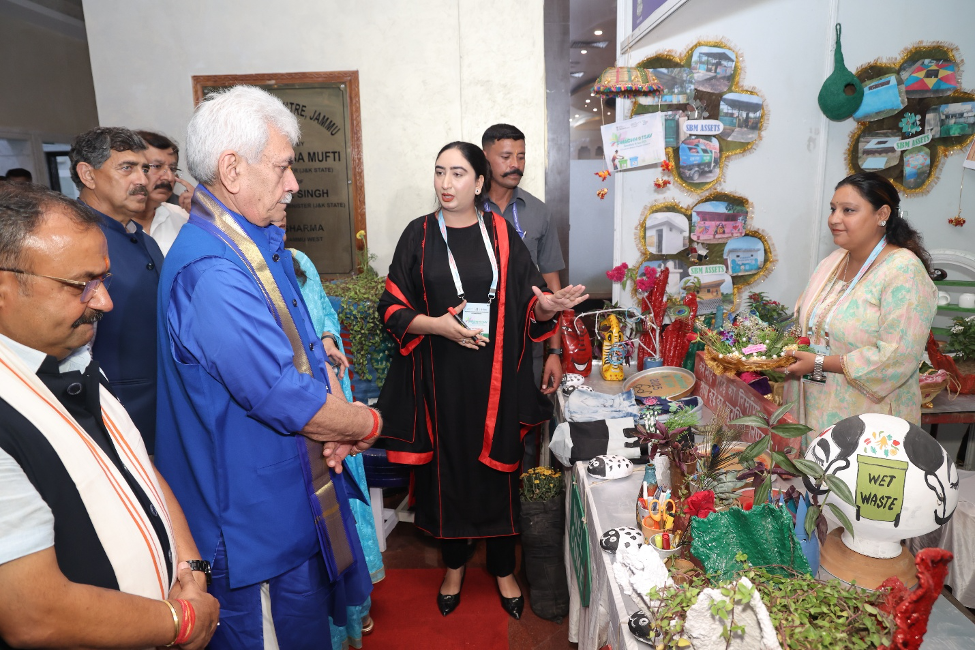
Major Events Across the Union Territory
The 15-day campaign was marked by a series of high-impact events, each reflecting the diversity of Jammu & Kashmir’s commitment to Swachhata.
The campaign was launched on September 17 by Hon’ble Minister for Rural Development & Panchayati Raj, Javid Ahmad Dar, from the picturesque Gulmarg, under the theme “Naqsh-e-Safai.”
A vibrant tableau, followed by a convoy of 50 hooper vehicles, moved across the districts of north Kashmir, spreading the message of cleanliness and environmental care.
On this occasion, legislators namely Irfan Hafiz (MLA Wagoora-Kreeri), Javid Riyaz (MLA Pattan) and Farooq Ahmad Shah (MLA Gulmarg) were nominated as Swachhata Ambassadors by the Directorate of Rural Sanitation, J&K. The legislators pledged to continue their efforts toward promoting sustainable models and advocate for behavioral change which is a vital component towards making J&K a model of Swachhata.
Students and youth volunteers added a visual spectacle by forming the SBM-G logo on the lush green slopes of Gulmarg, symbolizing the power of collective action and the pivotal role of youth in shaping a cleaner future.
Later, on September 29, the spotlight shifted to winter capital Jammu, where Hon’ble Lieutenant Governor of J&K, Shri Manoj Sinha graced the Swachhata Vijayotsav at the Convention Centre. The Lieutenant Governor released the Comprehensive Compendium on Swachhata Hi Seva 2025 and laid the foundation for 10 Gobardhan projects and 6 Faecal Sludge Treatment Plants (FSTPs) across J&K.
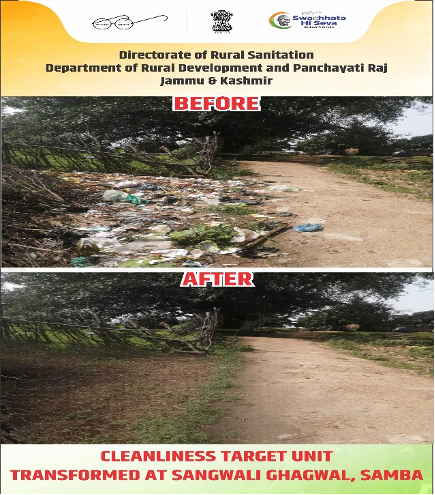
He lauded the efforts of the Directorate of Rural Sanitation; Department of Rural Development & Panchayati Raj, remarking that, “Cleanliness is not merely an act of sanitation, it reflects our civic sense, our values, and our responsibility towards the environment.”
The event also featured Waste-to-Wealth exhibitions, demonstrating how discarded materials we often throw carelessly on roadsides and water bodies only to choke them could be transformed into beautiful usable products of daily use, a visual lesson in circular economy and sustainable living.
The campaign’s concluding ceremony at RDD Park, Harwan, Srinagar, brought together key stakeholders and citizens in a collective celebration of achievement. Hon’ble Minister Javid Ahmad Dar commended the widespread public participation and urged people to uphold Swachhata as a daily practice. He was joined by Secretary RDD Mohammad Aijaz Assad (IAS), MLA Hazratbal Mr Salman Ali Sagar, Director General Rural Sanitation J&K, Ms Anoo Malhotra, and Director RDD (Kashmir) Mr Shabir Hussain Bhat, who reaffirmed the department’s resolve to strengthen decentralized waste management and promote innovative rural sanitation models.
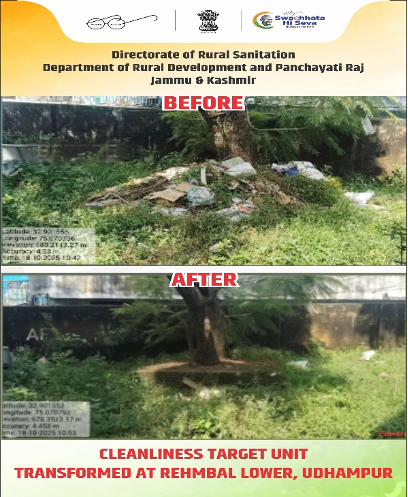
Highlights and Achievements
Swachhotsav 2025 was not merely a campaign, it was a canvas of creativity, collaboration, and community-driven results.
The activities reflected:
- Waste-to-Wealth Models: Panchayats showcased composting units, plastic recycling innovations, and Gobardhan projects that converted organic waste into biogas and organic manure, turning waste into opportunity.
- Sewa Parv Activities: The concept of service through cleanliness came alive in plantation drives, riverbank cleaning, Swachhata marathons, and green rallies across J&K.
- Panchayat-Led Models of Excellence: Several Gram Panchayats achieved ODF Plus Model status, setting benchmarks for solid and liquid waste management.
- Cultural and Educational Outreach: From wall murals to Swachhata quizzes, schools and youth groups creatively carried forward the mission.
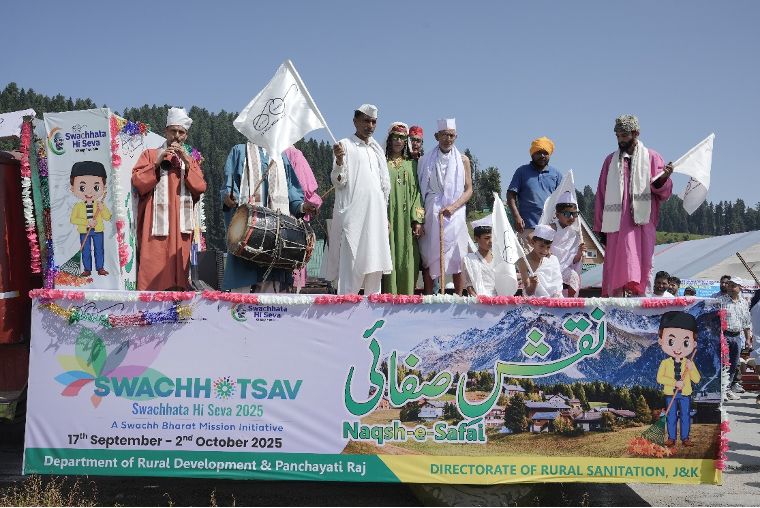
The Spirit of Collective Change
At its heart, Swachhotsav 2025 was about changing mindsets.
It was not only about cleaning spaces; it was about cultivating ownership and responsibility. It inspired pride among citizens, from volunteers sweeping village lanes to children educating their elders about waste segregation.
The campaign reaffirmed a vital truth: real cleanliness begins with behavioral change, sustained by community ownership and institutional support.
The Way Forward: Building on the momentum
As the campaign culminated on Gandhi Jayanti, it left behind not an end but a beginning, a renewed commitment toward a “Swachh Jammu & Kashmir.”
The Directorate of Rural Sanitation under the Department of Rural Development & Panchayati Raj envisions a future where every panchayat becomes a model of cleanliness, sustainability, and innovation.
Key priorities:
- Strengthening solid and liquid waste management systems in every Gram Panchayat.
- Expanding Gobardhan projects and bio-waste recycling to generate rural livelihoods.
- Establishing the first-of-its-kind SBM-G Center of Excellence at Wachi-Zainapora, Shopian, for research, training, and capacity building.
- Intensifying Information, Education, and Communication (IEC) campaigns to ensure lasting behavioral change across communities.
![]()
Conclusion
Swachhotsav – Swachhata Hi Seva 2025 has left an enduring imprint on the people of Jammu & Kashmir. It transformed the idea of Swachhata from a policy goal into a public movement of pride and purpose.
Cleanliness, as the campaign reminded everyone, is both a duty and a celebration, a shared responsibility that unites government, communities, and citizens in a single mission for progress.
Jammu & Kashmir stands as a shining example of how transformative change begins at the grassroots level through awareness, participation, and unwavering commitment to a cleaner tomorrow.
(Author is a public policy professional and currently works as Consultant–IEC for the Swachh Bharat Mission–Grameen.)

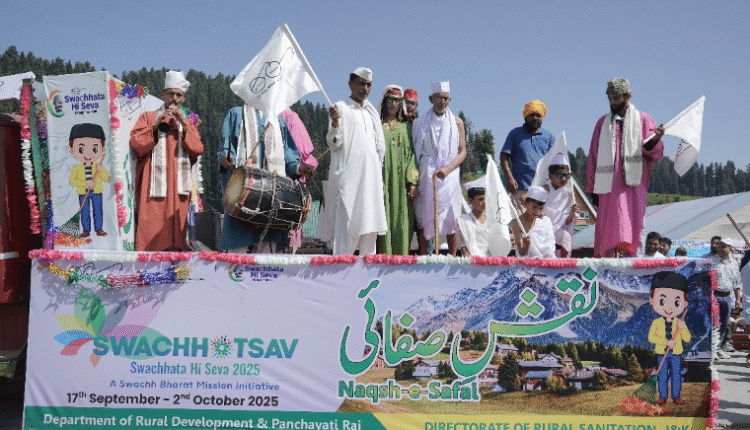

Comments are closed.